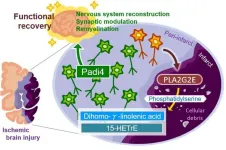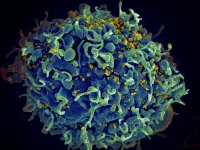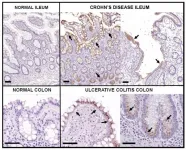(Press-News.org) Boston – Researchers from Dana-Farber Cancer Institute have found a way to use artificial intelligence (AI) to diagnose muscle wasting, called sarcopenia, in patients with head and neck cancer. AI provides a fast, automated, and accurate assessment that is too time-consuming and error-prone to be made by humans. The tool, published in JAMA Network Open, could be used by doctors to improve treatment and supportive care for patients.
“Sarcopenia is an indicator that the patient is not doing well. A real-time tool that tells us when a patient is losing muscle mass would trigger us to intervene and do something supportive to help,” says lead author Benjamin Kann, MD, a radiation oncologist in the Department of Radiation Oncology at Dana-Farber Brigham Cancer Center.
Head and neck cancers are typically treated with combinations of surgery, radiation, and chemotherapy. The treatments can be curative, but they also can have harsh side effects. Patients sometimes have trouble drinking and eating during and after treatment, leading to poor nutrition and sarcopenia.
Sarcopenia is associated with an increased chance of needing a feeding tube, having a lower quality of life, and worse outcomes in general, including earlier death. “Muscle mass is a very important indicator of health,” says Kann. “People with more muscle mass are generally healthier and more robust.”
Doctors can assess muscle mass by analyzing computed tomography (CT) scans of the abdomen or the neck. CT scans of the neck are common and frequent for patients with head and neck cancer, giving doctors an opportunity to identify sarcopenia early and intervene.
But diagnosis of sarcopenia from a CT scan requires a highly trained expert to examine the scan and differentiate the muscle from other tissue. It is painstaking work and takes up to 10 minutes to complete. “The process is time-consuming and burdensome, so it’s not done regularly,” says Kann.
Kann and colleagues set out to use deep learning, a form of AI, to diagnose sarcopenia using CT scans of the neck. To train the AI model, they accessed clinical records and CT scans from 420 patients with head and neck cancer. An expert performed an assessment of muscle mass for each patient based on the CT scans and calculated a skeletal muscle index (SMI) score. The team used the resulting dataset to train the deep learning model to make the same assessments.
“The AI model automatically delineates the muscle in the neck from other tissues,” says Kann. “The results are transparent. You can see the outline of the muscle as assessed by AI and verify it with your own eyes.”
The team used a second dataset containing similar data from a different patient group to validate the AI model’s ability to diagnose sarcopenia. In this test, the model made clinically acceptable assessments of muscle mass 96.2% of the time based on a review by an expert panel. The AI model completes an assessment of a scan in approximately 0.15 seconds.
Currently, doctors use body-mass index (BMI) as an indicator of a decline in health related to treatment. The team compared how well BMI and SMI predicted poor outcomes, such as earlier death or the need of a feeding tube. They found that SMI was a better predictor of poor outcomes, potentially making it a more valuable clinical tool.
“BMI is an imperfect measure,” says Kann. “It doesn’t tell you anything about fat content or muscle content, which are really the components we need to be measuring in the clinic.”
An AI-based assessment of sarcopenia could be made frequently throughout treatment, giving physicians a chance to recognize a patient’s decline before it reaches a critical point. That warning sign could trigger an intervention, such as a nutritional consult, supportive medication, or physical therapy.
“If we see muscle mass begin to decline, we can do something to prevent it,” says Kann.
The tool could also be used to guide treatment decisions up front. For instance, a patient who already has sarcopenia when diagnosed with cancer might fare better with gentler treatment than someone who is more physically robust.
For next steps, Kann and colleagues plan to apply the tool to scans throughout the course of treatment for patients in a clinical trial setting. They hope to learn more about how muscle mass changes during treatment and to learn how to use the information to guide treatments and interventions.
Funding: This study was funded by the National Institutes of Health, the European Union-European Research Council, the Radiological Society of North America, and Stichting Hanarth Fonds.
About Dana-Farber Cancer Institute
Dana-Farber Cancer Institute is one of the world’s leading centers of cancer research and treatment. Dana-Farber’s mission is to reduce the burden of cancer through scientific inquiry, clinical care, education, community engagement, and advocacy. Dana-Farber is a federally designated Comprehensive Cancer Center and a teaching affiliate of Harvard Medical School.
We provide the latest treatments in cancer for adults through Dana-Farber Brigham Cancer Center and for children through Dana-Farber/Boston Children’s Cancer and Blood Disorders Center. Dana-Farber is the only hospital nationwide with a top 5 U.S. News & World Report Best Cancer Hospital ranking in both adult and pediatric care.
As a global leader in oncology, Dana-Farber is dedicated to a unique and equal balance between cancer research and care, translating the results of discovery into new treatments for patients locally and around the world, offering more than 1,100 clinical trials.
END
AI-driven muscle mass assessment could improve care for head and neck cancer patients
Dana-Farber researchers have created and validated an AI model for diagnosing sarcopenia, a predictor of poor outcomes in head and neck cancer
2023-08-10
ELSE PRESS RELEASES FROM THIS DATE:
Alcohol consumption among adults with a cancer diagnosis
2023-08-10
About The Study: The findings of this study of 15,000 adults suggest that alcohol consumption and risky drinking behaviors were common among cancer survivors, even among individuals receiving treatment. Given the adverse treatment and oncologic outcomes associated with alcohol consumption, additional research and implementation studies are critical in addressing this emerging concern among cancer survivors.
Authors: Yin Cao, Sc.D., M.P.H., of the Washington University in St. Louis School of Medicine, is the corresponding author.
To ...
Five-year trajectories of prescription opioid use
2023-08-10
About The Study: The results of this study of 3.4 million adults suggest that most individuals commencing treatment with prescription opioids had relatively low and time-limited exposure to opioids over a 5-year period. The small proportion of individuals with sustained or increasing use was older with more comorbidities and use of psychotropic and other analgesic drugs, likely reflecting a higher prevalence of pain and treatment needs in these individuals.
Authors: Natasa Gisev, ...
A medication used for heart conditions improves the efficacy of current treatments for melanoma in mouse models
2023-08-10
The study, carried out by scientists from Navarrabiomed, the Institute of Neurosciences CSIC-UMH, and IRB Barcelona, has been published in Nature Metabolism.
In 2022, 7,500 new cases of melanoma—the most aggressive type of skin cancer—were diagnosed in Spain.
A collaborative study undertaken by the Navarrabiomed Biomedical Research Center (Pamplona, Navarre), the Institute of Neurosciences CSIC-UMH (Sant Joan d’Alacant, Valencian Community) and IRB Barcelona (Barcelona, Catalonia) shows that the administration of ranolazine, a drug currently used to treat heart conditions, improves the ...
Effectiveness of video gameplay restrictions questioned in new study
2023-08-10
Legal restrictions placed on the amount of time young people in China can play video games may be less effective than originally thought, a new study has revealed.
To investigate the effectiveness of the policy, a team of researchers led by the University of York, analysed over 7 billion hours of playtime data from tens of thousands of games, with data drawn from over two billion accounts from players in China, where legal restrictions on playtime for young people have been in place since 2019.
The research team, however, did not find evidence of a decrease in heavy play of games after these ...
A new mechanism encouraging the brain to self-repair after an ischemic stroke
2023-08-10
Researchers from Tokyo Medical and Dental University (TMDU) identify lipids stimulating self-repair mechanisms in the brain after ischemic stroke
Tokyo, Japan – Patients often experience functional decline after an ischemic stroke, especially due to the brain’s resistance to regenerate after damage. Yet, there is still potential for recovery as surviving neurons can activate repair mechanisms to limit and even reverse the damage caused by the stroke. How is it triggered though?
In a study published ...
Researchers find new pathway for HIV invasion of cell nucleus
2023-08-10
The researchers also identified three proteins that are needed for the virus to carry out the invasion and have in turn synthesized molecules (potential drugs) that can target one of the proteins, potentially leading to new treatments for AIDS.
“We have revealed a protein pathway that appears to have a direct impact on diseases, which opens up a new area for potential drug development,” says the study’s senior author Aurelio Lorico, MD PhD, Professor of Pathology and interim Chief Research Officer at Touro University Nevada College of Osteopathic Medicine.
HIV infection requires the virus to enter a cell and gain access to the well-guarded nucleus in order ...
MSK Research Highlights, August 10, 2023
2023-08-10
New research from Memorial Sloan Kettering Cancer Center (MSK) and the Sloan Kettering Institute — a hub for basic science and translational research within MSK — found a potential target against neuroendocrine transformation in lung and prostate cancers; discovered new clues about why donor T cells attack certain tissues in graft-versus-host disease; shed light on why T cells let go of their prey; and used CRISPR interference and dynamic cell-state transitions to discover enhancers that affect early human development.
Targeting exportin 1 may help prevent neuroendocrine transformation in lung and prostate cancers
Over time, some lung and prostate ...
Johns Hopkins researchers develop gut-restricted drug to treat IBD
2023-08-10
A new study of mice and lab-grown human colon “organoids” indicates that an experimental drug developed by Johns Hopkins Medicine researchers can substantially reduce symptoms of inflammatory bowel disease (IBD) in pre-clinical models.
The experimental drug, given orally, inhibits a gut enzyme that is overproduced in people and in animal models of IBD, a disorder estimated by the U.S. Centers for Disease Control and Prevention to afflict more than 3 million adult Americans.
A report on the new study was published Aug. 9 in Science Translational Medicine.
IBD, a disease category that includes Crohn’s ...
Course correction keeps Parker Solar Probe on track for Venus flyby
2023-08-10
NASA’s Parker Solar Probe executed a short maneuver on Aug. 3, 2023, that kept the spacecraft on track to hit the aim point for the mission’s sixth Venus flyby on Monday, Aug. 21, 2023.
Operating on preprogrammed commands from mission control at the Johns Hopkins Applied Physics Laboratory (APL) in Laurel, Maryland, Parker fired its small thrusters for 4.5 seconds, enough to adjust its trajectory by 77 miles and speed up – by 1.4 seconds – its closest approach to Venus. The precise timing and position are critical to that flyby, the sixth of seven approaches in which Parker uses the planet’s gravity to tighten ...
Computer-aided cell analysis for faster diagnosis of blood diseases
2023-08-10
Scientists from the German Cancer Research Center (DKFZ) and the Cambridge Stem Cell Institute have developed an AI system that recognizes and characterizes white and red blood cells in microscopic images of blood samples. The algorithm can help physicians diagnose blood disorders and is available as an open source method for research purposes.
Blood disorders are often characterized by altered numbers and aberrant shapes of red and white blood cells. To diagnose the diseases, physicians classically examine blood smears on a slide under a microscope. This type of diagnosis is straightforward, but evaluation by experienced experts is difficult because the changes are sometimes ...
LAST 30 PRESS RELEASES:
Home fingertip oxygen monitors less accurate for people with darker skin tones
Six weeks in a cast no less effective than surgery for unstable ankle fractures
Precautionary approach to alcohol-free and low alcohol drinks needed to protect public health, say experts
Gas-atomized Ca–Mg alloy powders produce hydrogen simply by adding water — high-efficiency hydrogen generation at room temperature
British redcoat’s lost memoir reveals harsh realities of life as a disabled veteran
World-leading rare earth magnet recycling facility launches in UK
Corday Selden selected for the Oceanography Society Early Career Award
MIT chemists determine the structure of the fuzzy coat that surrounds Tau proteins
Same moves, different terrain: How bacteria navigate complex environments without changing their playbook
Severe weather is deadly for vulnerable older adults long after the storm ends, study finds
Expert panel highlights opportunities for improving cancer studies
Hearing aid prescriptions not associated with changes in memory and thinking
Seth Zippel selected for The Oceanography Society Early Career Award
Jeremy Horowitz selected for The Oceanography Society Early Career Award
Kennesaw State University’s Jerry Mack named Paul “Bear” Bryant Newcomer Coach of the Year
Ancient teeth are treasure troves of data on Iron Age lifestyles
Avocados may become easier to grow in India—but not if global emissions remain high
Pregnant women with IBD show heightened inflammation in vaginal mucosa
Underwater photos show seabirds, seals and fish interacting with a tidal turbine in Washington State
1 in 5 surveyed UK adults who have experienced the death of a pet report it as more distressing than experienced human deaths, with significant rates of prolonged grief disorder symptoms also being re
Polyester microfibers in soil negatively impact the development of cherry tomato plants in experiments, raising concerns over the potential effect of high levels of such contaminants
LGBTQ+ adults may be around twice as likely to be unemployed or to report workforce non-participation compared to heterosexual adults, per large representative Australian survey
Horses can smell fear: In experiments where horses smelled sweat from scared humans, they reacted to scary and sudden events with increased fear and reduced human interaction
New synaptic formation in adolescence challenges conventional views of brain development
Scientists identify target to treat devastating brain disease
Oliver Zielinski selected as Fellow of The Oceanography Society
Has progress stalled on gender equality at work?
Quantum simulator sheds light on how nature moves energy in systems like photosynthesis and solar conversion
Can a hashtag help prevent atrocities? Study shows social media can be a powerful tool
The American Ornithological Society (AOS) announces the winner of the 2025 Wesley Lanyon Award
[Press-News.org] AI-driven muscle mass assessment could improve care for head and neck cancer patientsDana-Farber researchers have created and validated an AI model for diagnosing sarcopenia, a predictor of poor outcomes in head and neck cancer




